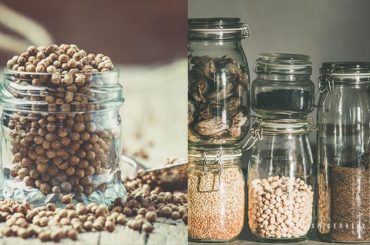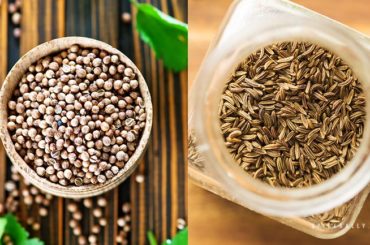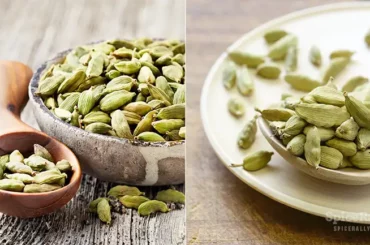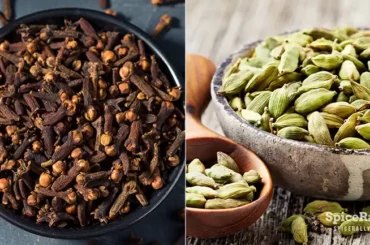If spices add soul to many of our dishes, turmeric and saffron are obviously among them that we should not resist talking about. So, this episode is dedicated to discussing all you need to know about turmeric vs saffron.
Saffron is the hand-picked stigma that comes from the flower of the Crocus sativus plant, while turmeric is the rhizome of Curcuma longa. And saffron is lighter in flavor and extremely labor-intensive, so it is considered the most expensive spice in the world. But turmeric is bold, earthy, and versatile, which is much more affordable.
So, if you got both of these spices in your kitchen or hoping to give them a try, let’s check out the facts you need to know about their differences and similarities.

Turmeric vs Saffron
| Turmeric | Saffron | |
|---|---|---|
| Flavor profile | Bolder, earthier, and potent than saffron with musky, warm, and slightly peppery undertones. | Less potent than turmeric with a delicate, earthy, sweet, and nuanced floral note. |
| Fragrance profile | The fragrance profile is not yet defined. But it is woodsy and mildly aromatized with hints of orange or ginger. | Has a subtle aroma, similar to metal honey, with a grassy or hay-like note, |
| Forms | – As fresh rhizomes – Dried rhizomes – Ground – Powdered – Paste – As teas – As an essential oil – Pills/ capsules | – Threads – Powder |
| Availability | Widely available in conventional and Asian grocery stores, supermarkets and with online sellers. | Genuine saffron is rare and hardly available. But still, you can find this spice with authentic sellers. |
| Cost | Less expensive than saffron. | The most expensive spice in the world. |
| Purpose in cooking | As an ingredient | – As an ingredient – As a garnish |
| Usage in cooking | – Used as a primary ingredient in most spice blends, seasoning mixtures, and curry pastes. – Incorporated into coconut milk-based curries. – Used to make tea, golden milk, juices, and smoothies. – Is a great addition to hearty soups and stews. – Can be added to sweets, desserts, and baked goods. Read more – 10 Best Practical Ways To Use Turmeric | – Can be added to rice, spaghetti, and pasta dishes. – In making certain chicken, clam, and fish dishes. – To make signature Greek dishes like Moussaka. – In desserts like saffron rice pudding and milk cake. – In shakes and ice creams. |
| General use | – In cooking and baking Asian communities like Hindus and Buddhists incorporate turmeric as a traditional ingredient for many of their spiritual and auspicious events. – Contemporary cosmetology and perfumery use this spice in making beauty products like creams, soaps, lotions, face wash, etc. – Used in DIY beauty hacks like face masks and scrubs. – Beneficial in modern and herbal medicine (Ayurveda and home remedies) | – In cooking and baking Used in manufacturing beauty products. – Used as traditional medicine. |
| Health benefits | – Lessens the inflammation in the body – Promotes cardiovascular health – Could work as an antidepressant – Its antimicrobial properties will be helpful for oral health – Contains anti-cancer properties – Helps to alleviate the symptoms of osteoarthritis – Aids in controlling and deterring diabetes – Helps to control eye degeneration – Detoxifies the liver – Stimulates skin health Read more – 10 Proven Health Benefits Of Turmeric | – Rich in antioxidants – Improves the mood and helps to control depression – Might contain anticarcinogenic properties – It might relieve symptoms of premenstrual syndrome – Boosts your libido – Contains properties that suppress appetite and promote weight loss – Might improve cognitive function – May enhance eyesight in adults with age-related macular degeneration (AMD) |
| Main featuring cuisines | Indian, Thai, Sri Lankan, and Middle Eastern cuisines | Mediterranean, European and Asian cuisines |
| Appearance | A bright yellow succulent rhizome in its natural form and a rich yellowish-golden powder when ground. | High-quality saffron threads and powder are vibrantly red in color. |
| Scientific name | Curcuma longa | Crocus sativus |
| Plant family | Zingiberaceae | Iridaceae |
| Active compounds | Curcuminoids/ curcumin | Crocin, crocetin, picrocrocin and safranal |
| Origin | Indonesia and Southern India | Greece |
| Shelf life | – Fresh turmeric can be kept well for about 6-9 months in the freezer – Powdered turmeric will stay up to 3-4 years when stored in an air-tight glass jar/container in a dry, dark, cool place. | – When stored in a well-fitting container, saffron threads will last for up to 2-3 years. – Should be kept away from direct sunlight in a cool, dry place. |
More About The Difference Between Turmeric And Saffron…
In essence, turmeric and saffron are definitely not the same. But both of them deserve a place in your spice cabinet as they have their own way of adding flavor and hue to your daily dishes. They can be somewhat similar in color, but they are significantly different in terms of taste, forms they come in, availability, cost, etc.
Out of the two, turmeric is the most used spice since it is widely available, comes in different forms, and is much more affordable than saffron. And turmeric can pair well with many other spices and herbs so that it can complement a wide variety of dishes. On the other hand, saffron will not complement less-moist food but is used with liquid dishes and as a garnish.
In addition, the polyphenol in turmeric, curcumin, is recognized as one most effective active compounds that will be beneficial in controlling, preventing, and protecting our bodies from many diseases. Saffron also contains some health benefits, but turmeric undoubtedly takes the lead when both are compared.
However, even though saffron is lighter and mild in flavor than turmeric, and turmeric is much bolder, both can be used interchangeably on many occasions. Especially if you are concerned about getting the color of liquid-based dishes, saffron can be used in place of turmeric and vice versa.




